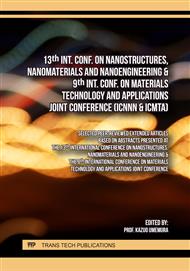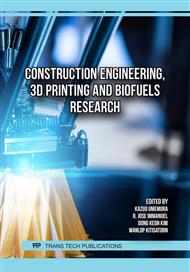[1]
B.-H. Lu, H.-B Lan, and H.-Z. Liu, "Additive manufacturing frontier: 3D printing electronics," Opto-Electronic Advances, vol. 1-1, pp.170004-1~10, Feb. 2018.
Google Scholar
[2]
X. Kuang, J. Wu, K. Chen, Z. Zhao, Z. Ding, F. Hu, D. Fang, and H. J. Qi, "Grayscale digital light processing 3D printing for highly functionally graded materials," Science Advances, vol. 5-5, eaav5790, May 2019.
DOI: 10.1126/sciadv.aav5790
Google Scholar
[3]
N. Lin, M. Gagnon, and K. Y. Wu, "The third dimension of eye care: A comprehensive review of 3D printing in ophthalmology," Hardware, Vol. 2, pp.1-32, Jan. 2024.
DOI: 10.3390/hardware2010001
Google Scholar
[4]
B. Derby, "Printing and Prototyping of Tissues and Scaffolds," Science, vol. 338, pp.921-926, Nov. 2012.
DOI: 10.1126/science.1226340
Google Scholar
[5]
M. Vaezi, H. Seitz, and S. Yang, "A review on 3D micro-additive manufacturing technologies," Int J Adv Manuf Technol, vol. 67, pp.1721-1754, Nov. 2012.
DOI: 10.1007/s00170-012-4605-2
Google Scholar
[6]
J. A. Lewis and B. Y. Ahn, "Three-dimensional printed electronics," Nature, vol. 518, pp.42-43, Feb. 2015.
Google Scholar
[7]
H. Lan, "Active mixing nozzle for multimaterial and multiscale: Three-dimensional printing," J Micro Nano-Manuf, vol. 5-4, p.040904, Dec. 2017.
DOI: 10.1115/1.4037831
Google Scholar
[8]
X. Y. Tian, L. X. Yin, D. C. Li, "Current situation and trend of fabrication technologies for three-dimensional metamaterials," Opto-Electronic Engineering, vol. 44-1, pp.69-76, Dec. 2016.
Google Scholar
[9]
H. Quan, T. Zhang, H. Xu, S. Luo, J. Nie, and X. Zhu, "Photo-curing 3D printing technique and its challenges," Bioactive Materials, Vol. 5-1, pp.110-115, Jan. 2020.
DOI: 10.1016/j.bioactmat.2019.12.003
Google Scholar
[10]
C. Lin, W. Xu, B. Liu, H. Wang, H. Xing, Q. Sun, and J. Xu, "Three-dimensional printing of large objects with high resolution by dynamic projection scanning lithography," Micromachines, vol. 14, p.1700, Aug. 2023.
DOI: 10.3390/mi14091700
Google Scholar
[11]
X. Wang, J. Liu, Y. Zhang, P. M. Kristiansen, A. Islam, M. Gilchrist, and N. Zhang, "Advances in precision microfabrication through digital light processing system development, material and applications," Virtual and Physical Prototyping, vol. 18-1, p. e2248101, Aug. 2023.
DOI: 10.1080/17452759.2023.2248101
Google Scholar
[12]
J. Huang, B. Zhang, J. Xiao, and Q. Zhang, "An approach to improve the resolution of DLP 3D printing by parallel mechanism," Applied Sciences, vol. 12, p.12905, Dec. 2022.
DOI: 10.3390/app122412905
Google Scholar
[13]
H. G. Hosseinabadi, D. Nieto, A. Yousefinejad, H. Fattel, L. Ionov, and A.r K. Miri, "Ink material selection and optical design considerations in DLP 3D printing," Applied Materials Today, vol. 30, p.101721, Dec. 2022.
DOI: 10.1016/j.apmt.2022.101721
Google Scholar
[14]
E. Behroodi, H Latifi, and F Najafi, "A compact LED-based projection microstereolithography for producing 3D microstructures," Scientific Reports, vol. 9, p.19692, Dec. 2019.
DOI: 10.1038/s41598-019-56044-3
Google Scholar
[15]
Q. Ge, Z. Li, Z. Wang, K. Kowsari, W. Zhang, X. He, J. Zhou, and N. X. Fang, "Projection micro stereolithography based 3D printing and its applications," Int. J. Extrem. Manuf., vol. 2, p.022004, June 2020.
DOI: 10.1088/2631-7990/ab8d9a
Google Scholar



